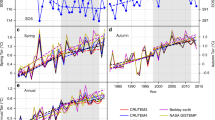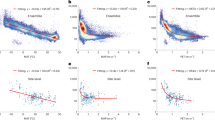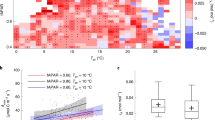Abstract
Diurnal cycling of plant carbon uptake and water use, and their responses to water and heat stresses, provide direct insight into assessing ecosystem productivity, agricultural production and management practices, carbon and water cycles, and feedbacks to the climate. Temperature, light, atmospheric water demand, soil moisture and leaf water potential vary over the course of the day, leading to diurnal variations in stomatal conductance, photosynthesis and transpiration. Earth observations from polar-orbiting satellites are incapable of studying these diurnal variations. Here, we review the emerging satellite observations that have the potential for studying how plant functioning and ecosystem processes vary over the course of the diurnal cycle. The recently launched ECOsystem Spaceborne Thermal Radiometer Experiment on Space Station (ECOSTRESS) and Orbiting Carbon Observatory-3 (OCO-3) provide land surface temperature, evapotranspiration (ET), gross primary production (GPP) and solar-induced chlorophyll fluorescence data at different times of day. New generation operational geostationary satellites such as Himawari-8 and the GOES-R series can provide continuous, high-frequency data of land surface temperature, solar radiation, GPP and ET. Future satellite missions such as GeoCarb, TEMPO and Sentinel-4 are also planned to have diurnal sampling capability of solar-induced chlorophyll fluorescence. We explore the unprecedented opportunities for characterizing and understanding how GPP, ET and water use efficiency vary over the course of the day in response to temperature and water stresses, and management practices. We also envision that these emerging observations will revolutionize studies of plant functioning and ecosystem processes in the context of climate change and that these observations and findings can inform agricultural and forest management and lead to improvements in Earth system models and climate projections.
This is a preview of subscription content, access via your institution
Access options
Access Nature and 54 other Nature Portfolio journals
Get Nature+, our best-value online-access subscription
$29.99 / 30 days
cancel any time
Subscribe to this journal
Receive 12 digital issues and online access to articles
$119.00 per year
only $9.92 per issue
Buy this article
- Purchase on Springer Link
- Instant access to full article PDF
Prices may be subject to local taxes which are calculated during checkout






Similar content being viewed by others
Data availability
The data that support the findings of this study are available from https://earthdata.nasa.gov (ECOSTRESS), https://lpdaacsvc.cr.usgs.gov/appeears/ (ECOSTRESS), https://ocov3.jpl.nasa.gov/science/oco-3-data-center/ (OCO-3), http://data.ozflux.org.au (flux tower data), https://data.nas.nasa.gov/geonex/ (Himawari-8), ftp://hmwr829gr.cr.chiba-u.ac.jp/gridded/FD/V20151105/ (Himawari-8) and https://land.copernicus.eu/global/products/ (global geostationary satellite LST data).
References
Hennessey, T. L., Freeden, A. L. & Field, C. B. Environmental effects on circadian rhythms in photosynthesis and stomatal opening. Planta 189, 369–376 (1993).
Steed, G., Ramirez, D. C., Hannah, M. A. & Webb, A. A. R. Chronoculture, harnessing the circadian clock to improve crop yield and sustainability. Science 372, eabc9141 (2021).
Zhao, T. B. & Dai, A. G. The magnitude and causes of global drought changes in the twenty-first century under a low–moderate emissions scenario. J. Clim. 28, 4490–4512 (2015).
Perkins-Kirkpatrick, S. E. & Gibson, P. B. Changes in regional heatwave characteristics as a function of increasing global temperature. Sci. Rep. 7, 12256 (2017).
Bates, L. M. & Hall, A. E. Stomatal closure with soil-water depletion not associated with changes in bulk leaf water status. Oecologia 50, 62–65 (1981).
Roessler, P. G. & Monson, R. K. Midday depression in net photosynthesis and stomatal conductance in Yucca-Glauca—relative contributions of leaf temperature and leaf-to-air water-vapor concentration difference. Oecologia 67, 380–387 (1985).
Tenhunen J. D., Pearcy R. W. & Lange O. L. in Stomatal Function (eds Zeiger, E. et al.) Ch. 15 (Stanford Univ. Press, 1987).
Tucci, M. L. S., Erismann, N. M., Machado, E. C. & Ribeiro, R. V. Diurnal and seasonal variation in photosynthesis of peach palms grown under subtropical conditions. Photosynthetica 48, 421–429 (2010).
Kosugi, Y. & Matsuo, N. Seasonal fluctuations and temperature dependence of leaf gas exchange parameters of co-occurring evergreen and deciduous trees in a temperate broad-leaved forest. Tree Physiol. 26, 1173–1184 (2006).
Koch, G. W., Amthor, J. S. & Goulden, M. L. Diurnal patterns of leaf photosynthesis, conductance and water potential at the top of a lowland rain-forest canopy in Cameroon—measurements from the Radeau-Des-Cimes. Tree Physiol. 14, 347–360 (1994).
Olioso, A., Carlson, T. N. & Brisson, N. Simulation of diurnal transpiration and photosynthesis of a water stressed soybean crop. Agric. For. Meteorol. 81, 41–59 (1996).
Cowan, I. R. & Farquhar, G. D. Stomatal function in relation to leaf metabolism and environment: stomatal function in the regulation of gas exchange. Symposia Soc. Exp. Biol. 31, 471–505 (1977).
Bollig, C. & Feller, U. Impacts of drought stress on water relations and carbon assimilation in grassland species at different altitudes. Agric. Ecosyst. Environ. 188, 212–220 (2014).
Koyama, K. & Takemoto, S. Morning reduction of photosynthetic capacity before midday depression. Sci. Rep. 4, 4389 (2014).
Nelson, J. A., Carvalhais, N., Migliavacca, M., Reichstein, M. & Jung, M. Water-stress-induced breakdown of carbon–water relations: indicators from diurnal FLUXNET patterns. Biogeosciences 15, 2433–2447 (2018).
Xu, H., Xiao, J. F. & Zhang, Z. Q. Heatwave effects on gross primary production of northern mid-latitude ecosystems. Environ. Res. Lett. 15, 074027 (2020).
Baldocchi, D. et al. FLUXNET: a new tool to study the temporal and spatial variability of ecosystem-scale carbon dioxide, water vapor, and energy flux densities. Bull. Am. Meteorol. Soc. 82, 2415–2434 (2001).
Running, S. W. et al. A continuous satellite-derived measure of global terrestrial primary production. Bioscience 54, 547–560 (2004).
Xiao, J. F. et al. A continuous measure of gross primary production for the conterminous United States derived from MODIS and AmeriFlux data. Remote Sens. Environ. 114, 576–591 (2010).
Anderson, M. C., Allen, R. G., Morse, A. & Kustas, W. P. Use of Landsat thermal imagery in monitoring evapotranspiration and managing water resources. Remote Sens. Environ. 122, 50–65 (2012).
Sun, Y. et al. OCO-2 advances photosynthesis observation from space via solar-induced chlorophyll fluorescence. Science 358, eaam5747 (2017).
Mu, Q., Heinsch, F. A., Zhao, M. & Running, S. W. Development of a global evapotranspiration algorithm based on MODIS and global meteorology data. Remote Sens. Environ. 111, 519–536 (2007).
Fisher, J. B. et al. ECOSTRESS: NASA’s next generation mission to measure evapotranspiration from the International Space Station. Water Resour. Res. 56, 1–20 (2020).
Hook, S. J. et al. In-flight validation of ECOSTRESS, Landsat 7 and 8 thermal infrared spectral channels using the Lake Tahoe CA/NV and Salton Sea CA automated validation sites. IEEE Trans. Geosci. Remote Sens. 58, 1294–1302 (2019).
Hulley, G., Shivers, S., Wetherley, E. & Cudd, R. New ECOSTRESS and MODIS land surface temperature data reveal fine-scale heat vulnerability in cities: a case study for Los Angeles County, California. Remote Sens. 11, 2136 (2019).
Anderson, M. C. et al. Interoperability of ECOSTRESS and Landsat for mapping evapotranspiration time series at sub-field scales. Remote Sens. Environ. 252, 112189 (2021).
Anderson, M. C. et al. An intercomparison of drought indicators based on thermal remote sensing and NLDAS-2 simulations with US drought monitor classifications. J. Hydrometeorol. 14, 1035–1056 (2013).
Li, X., Xiao, J., Fisher, J. B. & Baldocchi, D. D. ECOSTRESS estimates gross primary production with fine spatial resolution for different times of day from the International Space Station. Remote Sens. Environ. 258, 112360 (2021).
Hulley, G. C. et al. Validation and quality assessment of the ECOSTRESS level-2 land surface temperature and emissivity product. IEEE Trans. Geosci. Remote Sens. https://doi.org/10.1109/TGRS.2021.3079879 (2021).
Aragon, B., Houborg, R., Tu, K., Fisher, J. B. & McCabe, M. CubeSats enable high spatiotemporal retrievals of crop-water use for precision agriculture. Remote Sens. 10, 1867 (2018).
Fisher, J. B. et al. The future of evapotranspiration: global requirements for ecosystem functioning, carbon and climate feedbacks, agricultural management, and water resources. Water Resour. Res. 53, 2618–2626 (2017).
Turner, N. C., Schulze, E.-D. & Gollan, T. The responses of stomata and leaf gas exchange to vapour pressure deficits and soil water content. Oecologia 65, 348–355 (1985).
Moore, G. W. & Heilman, J. L. Proposed principles governing how vegetation changes affect transpiration. Ecohydrology 4, 351–358 (2011).
Hulley, G. C. & Hook, S. J. Generating consistent land surface temperature and emissivity products between ASTER and MODIS data for earth science research. IEEE Trans. Geosci. Remote Sens. 49, 1304–1315 (2011).
Fisher, J. B., Whittaker, R. H. & Malhi, Y. ET Come Home: a critical evaluation of the use of evapotranspiration in geographical ecology. Glob. Ecol. Biogeogr. 20, 1–18 (2011).
Talsma, C. J. et al. Partitioning of evapotranspiration in remote sensing-based models. Agric. For. Meteorol. 260, 131–143 (2018).
Otkin, J. A. et al. Examining rapid onset drought development using the thermal infrared-based evaporative stress index. J. Hydrometeorol. 14, 1057–1074 (2013).
Stavros, E. N. et al. ISS observations offer insights into plant function. Nat. Ecol. Evolution 1, 0194 (2017).
Taylor, T. E. et al. OCO-3 early mission operations and initial (vEarly) XCO2 and SIF retrievals. Remote Sens. Environ. 251, 112032 (2020).
Frankenberg, C. et al. The Orbiting Carbon Observatory (OCO-2): spectrometer performance evaluation using pre-launch direct sun measurements. Atmos. Meas. Tech. 8, 301–313 (2015).
Bilger, W., Schreiber, U. & Bock, M. Determination of the quantum efficiency of photosystem-II and of nonphotochemical quenching of chlorophyll fluorescence in the field. Oecologia 102, 425–432 (1995).
Maguire, A. J. et al. On the functional relationship between fluorescence and photochemical yields in complex evergreen needleleaf canopies. Geophys. Res. Lett. 47, e2020GL087858 (2020).
Marrs, J. K. et al. Solar-induced fluorescence does not track photosynthetic carbon assimilation following induced stomatal closure. Geophys. Res. Lett. 47, e2020GL087956 (2020).
Li, X. et al. Solar-induced chlorophyll fluorescence is strongly correlated with terrestrial photosynthesis for a wide variety of biomes: first global analysis based on OCO-2 and flux tower observations. Glob. Change Biol. 24, 3990–4008 (2018).
Frankenberg, C. et al. New global observations of the terrestrial carbon cycle from GOSAT: patterns of plant fluorescence with gross primary productivity. Geophys. Res. Lett. 38, L17706 (2011).
Li, X. & Xiao, J. F. Mapping photosynthesis solely from solar-induced chlorophyll fluorescence: a global, fine-resolution dataset of gross primary production derived from OCO-2. Remote Sens. 11, 2563 (2019).
Liu, J. J. et al. Contrasting carbon cycle responses of the tropical continents to the 2015–2016 El Nino. Science 358, eaam5690 (2017).
Parazoo, N. C. et al. Towards a harmonized long-term spaceborne record of far-red solar-induced fluorescence. J. Geophys. Res. 124, 2518–2539 (2019).
He, L. Y. et al. Tracking seasonal and interannual variability in photosynthetic downregulation in response to water stress at a temperate deciduous forest. J. Geophys. Res. 125, e2018JG005002 (2020).
Lin, C. J. et al. Evaluation and mechanism exploration of the diurnal hysteresis of ecosystem fluxes. Agric. For. Meteorol. 278, 107642 (2019).
Magney, T. S. et al. Mechanistic evidence for tracking the seasonality of photosynthesis with solar-induced fluorescence. Proc. Natl Acad. Sci. USA 116, 11640–11645 (2019).
Yang, X. et al. FluoSpec 2—an automated field spectroscopy system to monitor canopy solar-induced fluorescence. Sensors (Basel) 18, 2063 (2018).
Miura, T., Nagai, S., Takeuchi, M., Ichii, K. & Yoshioka, H. Improved characterisation of vegetation and land surface seasonal dynamics in central Japan with Himawari-8 hypertemporal data. Sci. Rep. 9, 15692 (2019).
Bessho, K. et al. An introduction to Himawari-8/9—Japan’s new-generation geostationary meteorological satellites. J. Meteorological Soc. Jpn 94, 151–183 (2016).
Schmit, T. J. et al. A closer look at the ABI on the GOES-R series. Bull. Am. Meteorol. Soc. 98, 681–698 (2017).
Oh, S. M., Borde, R., Carranza, M. & Shin, I. C. Development and intercomparison study of an atmospheric motion vector retrieval algorithm for GEO-KOMPSAT-2A. Remote Sens. 11, 2054 (2019).
Yang, J., Zhang, Z. Q., Wei, C. Y., Lu, F. & Guo, Q. Introducing the new generation of Chinese geostationary weather satellites, Fengyun-4. Bull. Am. Meteorol. Soc. 98, 1637–1658 (2017).
Ouaknine, J. et al. The FCI on Board MTG: optical design and performances. In International Conference on Space Optics—ICSO 2014 (eds Sodnik, Z. et al.) 1056323 (SPIE, 2014).
Wang, W. et al. An introduction to the Geostationary-NASA Earth Exchange (GeoNEX) products: 1. Top-of-atmosphere reflectance and brightness temperature. Remote Sens. 12, 1267 (2020).
Yamamoto, Y., Ishikawa, H., Oku, Y. & Hu, Z. Y. An algorithm for land surface temperature retrieval using three thermal infrared bands of Himawari-8. J. Meteorological Soc. Jpn. 96B, 59–76 (2018).
Yu, Y. & Yu, P. in The GOES-R Series. A New Generation of Geostationary Environmental Satellites (eds Goodman, S. J. et al.) Ch. 12 (2020).
Takenaka, H. et al. Estimation of solar radiation using a neural network based on radiative transfer. J. Geophys. Res. 116, D08215 (2011).
Hashimoto, H. et al. Hourly GPP estimation in Australia using Himawari-8 AHI products. In IGARSS 2020—2020 IEEE International Geoscience and Remote Sensing Symposium 4513–4515 (IEEE, 2020).
Yan, K. et al. Evaluation of MODIS LAI/FPAR product collection 6. Part 1: consistency and improvements. Remote Sens. 8, 359 (2016).
Moore, B. et al. The potential of the Geostationary Carbon Cycle Observatory (GeoCarb) to provide multi-scale constraints on the carbon cycle in the Americas. Front. Environ. Sci. https://doi.org/10.3389/fenvs.2018.00109 (2018).
Zoogman, P. et al. Tropospheric emissions: monitoring of pollution (TEMPO). J. Quant. Spectrosc. Radiat. Transf. 186, 17–39 (2017).
Courrèges-Lacoste, G. B. et al. Knowing what we Breathe: Sentinel 4: a Geostationary Imaging UVN Spectrometer for Air Quality Monitoring. In International Conference on Space Optics—ICSO 2016 (eds Karafolas, N. et al.) 105621J (SPIE, 2017).
Wekerle, T., Pessoa, J. B., da Costa, L. & Trabasso, L. G. Status and trends of smallsats and their launch vehicles—an up-to-date review. J. Aerosp. Technol. Manag. 9, 269–286 (2017).
Ryswyk, M. V. Planet announces 50 cm SkySat imagery, tasking dashboard and up to 12× revisit. Planet (9 June 2020); https://www.planet.com/pulse/tasking-dashboard-50cm-12x-revisit-announcement/
Blackwell, W. J. et al. An overview of the TROPICS NASA Earth Venture mission. Q. J. R. Meteorol. Soc. 144, 16–26 (2018).
Gao, F., Masek, J., Schwaller, M. & Hall, F. On the blending of the Landsat and MODIS surface reflectance: predicting daily Landsat surface reflectance. IEEE Trans. Geosci. Remote Sens. 44, 2207–2218 (2006).
Franco, A. C. & Luttge, U. Midday depression in savanna trees: coordinated adjustments in photochemical efficiency, photorespiration, CO2 assimilation and water use efficiency. Oecologia 131, 356–365 (2002).
Keller, M., Schimel, D. S., Hargrove, W. W. & Hoffman, F. M. A continental strategy for the National Ecological Observatory Network. Front. Ecol. Environ. 6, 282–284 (2008).
Acknowledgements
This study was supported by the NASA’s ECOSTRESS Science and Applications Team (80NSSC20K0167) (J.X.), NASA’s Climate Indicators and Data Products for Future National Climate Assessments (NNX16AG61G) (J.X.), the National Science Foundation (Macrosystem Biology & NEON-Enabled Science program: DEB-2017870, EF-1638688) (J.X.), NASA’s ECOSTRESS (J.B.F.), NASA Earth Exchange (NEX) from NASA’s Earth Science Division (H.H.), the Virtual Laboratory (VL) project by the Ministry of Education, Culture, Sports, Science and Technology (MEXT), Japan (K.I.), a research grant of the Japan Society for the Promotion of Science (JSPS), KAKENHI (20K20487) (K.I.), and the Earth Science Division OCOST program (N.C.P.). J.B.F. and N.C.P. carried out their research at the Jet Propulsion Laboratory, California Institute of Technology, under a contract with NASA. California Institute of Technology. Government sponsorship acknowledged. A portion of these data were produced by the OCO-3 project at the Jet Propulsion Laboratory, California Institute of Technology, and obtained from the OCO-3 data archive at the NASA Goddard Earth Science Data and Information Services Center. G. Halverson provided ECOSTRESS visualization. Himawari-8 AHI-based LST data used in this study were provided by Y. Yamamoto, Chiba University, Japan.
Author information
Authors and Affiliations
Contributions
J.X. conceived the idea. J.X., J.B.F., H.H., K.I. and N.C.P. designed the research, conducted the analyses, interpreted the data and wrote the paper.
Corresponding author
Ethics declarations
Competing interests
The authors declare no competing interests.
Additional information
Peer review information Nature Plants thanks Gerbrand Koren, Steve Running and Changliang Shao for their contribution to the peer review of this work.
Publisher’s note Springer Nature remains neutral with regard to jurisdictional claims in published maps and institutional affiliations.
Supplementary information
Supplementary Information
Supplementary Figs. 1–3.
Rights and permissions
About this article
Cite this article
Xiao, J., Fisher, J.B., Hashimoto, H. et al. Emerging satellite observations for diurnal cycling of ecosystem processes. Nat. Plants 7, 877–887 (2021). https://doi.org/10.1038/s41477-021-00952-8
Received:
Accepted:
Published:
Issue Date:
DOI: https://doi.org/10.1038/s41477-021-00952-8
This article is cited by
-
GOES-R land surface products at Western Hemisphere eddy covariance tower locations
Scientific Data (2024)
-
Solar-Induced Chlorophyll Fluorescence (SIF): Towards a Better Understanding of Vegetation Dynamics and Carbon Uptake in Arctic-Boreal Ecosystems
Current Climate Change Reports (2024)
-
Tropical forests are approaching critical temperature thresholds
Nature (2023)
-
Optical vegetation indices for monitoring terrestrial ecosystems globally
Nature Reviews Earth & Environment (2022)
-
Role of space station instruments for improving tropical carbon flux estimates using atmospheric data
npj Microgravity (2022)



